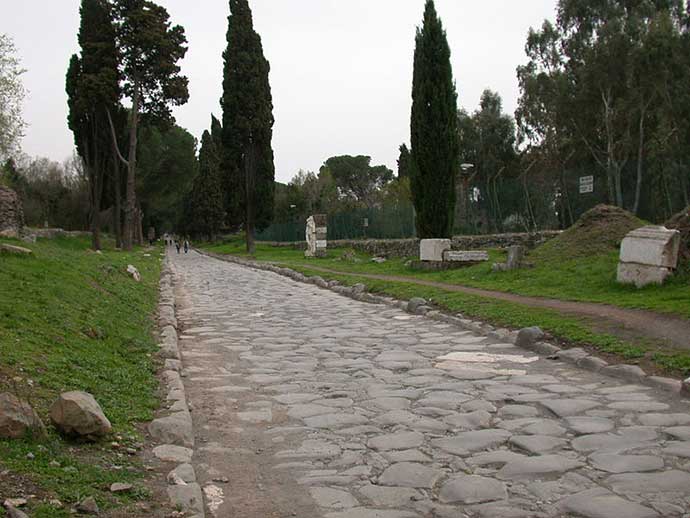
The Roman Empire reached its greatest geographic extent under the reign of Emperor Trajan (ruled 98 – 117 AD).
Trajan’s wars of conquest extended Roman territory to around 5 million square kilometres. Though he is considered one of the ‘5 Good Emperors’ of Rome due to his unsurpassed military successes, the huge landmass that the Empire encompassed during his tenure required an extensive trade and transport network to keep it connected, controlled and fed.
 Watch Now
Watch NowIt was Trajan’s successor, Emperor Hadrian (ruled 117 – 138) who would bring the Empire to a more manageable size by abandoning Trajan’s eastern conquests. He travelled extensively throughout Roman territory, securing its outposts, shaping up the military and improving infrastructure.
An empire of trade

Political map of Europe in 180AD showing various Roman trade routes and important trade goods. (Image Credit: Adhavoc / CC).
Roman transport in this era was based on sea routes and roads. Trade was made simpler by the use of a single Roman currency.
The roads connected the cities of the Empire, while the Mediterranean was the centre of a network of coastal ports and facilitated a great amount of trade.
River transport was not extensively used within the Empire, as rivers, such as the Rhine and Danube, generally served as political borders rather than trade routes.
The chief amount of trade occurred between Rome and Spain, France, the Middle East and North Africa. Besides the large amounts of grain — the Empire’s principal commodity — that arrived from Africa to feed Rome and its armies, traded goods included iron, cattle, spices, wood, leather, marble, glass corn, precious and semi-precious metals and silk.
 Listen Now
Listen NowBritannia supplied tin, lead and wool to Rome and provided a market for Mediterranean goods like wine, olive oil, ceramics and papyrus.
All roads lead to Rome

The Via Appia (Appian Way) in Rome. Credit: MM (Wikimedia Commons).
Roads were also borders, but had the primary function of transporting goods and the Roman military. Travel speed along the road was facilitated by posthouses with fresh horses every 15 kilometres or so. Lodgings were located around every 40 km, an average day’s journey at the time. A courier could normally travel 80 km in a day.
The first main Roman Road was the Appian Way, began by Appius Claudius Caecus while he was censor in 312 BC. At the time most roads were Etruscan and served the needs of their culture so roads that would facilitate Roman military transport were of the utmost importance to the Republic.
By the end of the Republican era, Romans were masters of road making and their roads branched out from the capital and extended throughout Italy.
By 200 AD a network of ‘first class’ Roman roads spanned some 80,000 km in total, from North Africa in the south to Antioch in the east, Britannia in the north and Lusitania (Portugal) in the west.
First class roads were characterised by a minimum width of 5 metres and a surface of drained stone. The world’s first dual carriage way was a Roman road, the Via Portuensis, which connected Rome and its port of Ostia.
The golden milestone
In the central forum of Rome was a monument known as the Millarium Aureum or Golden Milestone, which was erected by Rome’s first Emperor, Augustus in 20 BC. It is believed that the milestone listed all of the Empire’s major cities and their distance from Rome. A symbol of the Roman culture’s greatness in engineering, it is where ‘all roads’ emanated from.
 Watch Now
Watch NowMare Nostrum – ‘Our Sea’
The population of the city of Rome surpassed 1 million at its height and the network of roads and shipping routes were centred around the capital and its wealth. The Empire engulfed the entire Mediterranean, which the Romans used to their advantage.
Lighthouses and numerous docks helped the safe passage of ships, while the Roman Navy protected shipping routes from piracy.
The ships themselves were largely built by Greeks and Egyptians, who were more sea-faring peoples than the Romans.
From North Africa, the grain that fed the city and beyond arrived through the port of Ostia, mainly from Egyptian ports, which also brought silk from China and goods like spices and incense from the Indian subcontinent.
In the later states of the Empire, the capture of Ostia was key to Alaric’s victory over Rome in 409 AD. By controlling Ostia an enemy could effectively starve the city.

A gold Roman coin featuring the image of Emperor Trajan, found in a Buddhist monastery in Afghanistan, indicating the range of Roman trade. From the British Museum.














